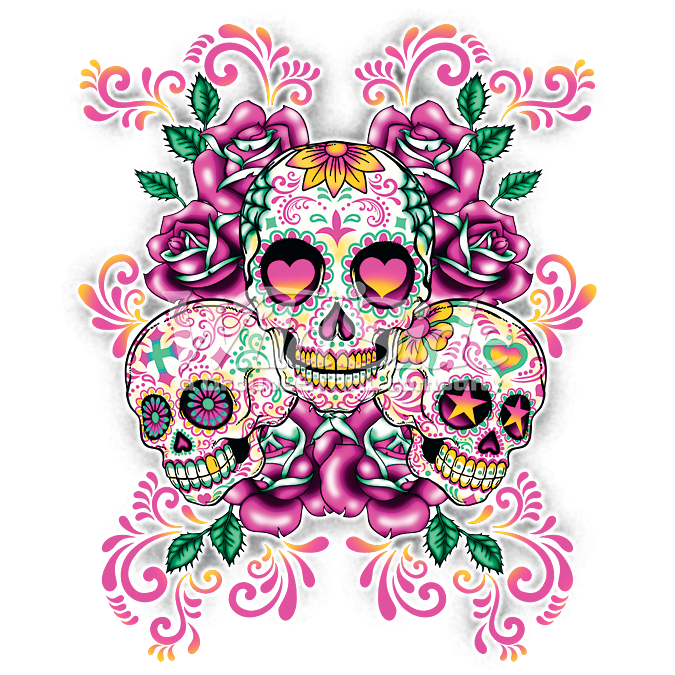

The image of a calavera most commonly associated with Dia de los Muertos now is that of La Calavera Catrina, a skeletal portrait of a high society lady.

The day itself was moved by Pope Gregory III to November 1 to suppress pagan religious festivals. The shared Catholic faith of Latin America brings with it a religious influence which is often displayed in the face painting, which is coupled with both traditional Aztec influences and European symbolism. Day of the dead flat style banner, greeting card, invitation, party poster, flyer etc. The face masks are traditionally molded from sugar and decorated with glitter, feathers and anything else for the celebrations.Īs the celebration has become more and more popular, these sugar skulls have been translated onto face paint, providing the perfect outfit for the occasion. Dia de los muertos colorful design template with skulls and flowers Dia de los muertos colorful design template with skulls and mexiacan flowers. Support JSTOR Daily! Join our new membership program on Patreon today.At Dia de los Muertos celebrations in much of Latin America, la calavera de azucar, or a ‘sugar skull’, is a common sight. They read into this imagery the meaning of Mexico itself. What is likely Posada’s most famous calavera was la catrina, the female dandy, portrayed as a fleshless skull, topped with a fancy, wide-brimmed hat replete with large billowing feathers and other decorations.Ĭalaveras on political broadsides were just one of many forms of popular resistance by writers and artists, including the triad of Mexican muralists: Diego Rivera, David Alfaro Siquieros, and José Clemente Orozco, both within and outside of Mexico. In a new country with a tenuous political framework, in which outlets for criticism were highly restricted, the illustrations of lithographer José Guadalupe Posada (1852–1913) found an eager market. During the second half of the nineteenth century, the country’s newfound freedom of the press led to an explosion in the publication of broadsides-called calaveras, or skulls.

Death was everywhere, coming to be represented in popular arts and holiday foodways.Īnother crucial development came after Mexico’s independence from Spain in 1821, writes Brandes. Your kids will love decorating these colorful holders as the focal point for your altar. A DIY pumpkin will make a stunning centerpiece, ideal for a Day of the Dead altar. He argues that Día de los Muertos became ritualistically elaborate in Mexico as a by-product of this loss of life: The population of central Mexico went from over 25 million in 1519 to just over 1 million in 1605. These candle holders are an easy Día de Los Muertos craft project. Eventually, these anthropomorphic dough figurines, combined with Spanish ritual practice, resulted in the Mexican custom of edible Day of the Dead figurines.Īn important factor on that path, according to Brandes, was the astoundingly high mortality rates that followed the invasion. Spanish ritual practices on All Souls’ Day included offering food at cemeteries in honor of the dead one custom in Aztec commemorations of the deceased or of certain deities was making figures out of wood, covering them with tzoalli, or amaranth seed dough, then eating the resulting pastry.

Calavera de la Catrina via Wikimedia Commonsīut as Brandes writes, the Spanish empire, for its part, was strongly influenced by Europe’s seventeenth-century Baroque period, a time of skull and skeleton ornamentation. Nor do skeletons appear during Aztecs burials: Brandes concludes that skull and skeletal imagery in Mesoamerica is not all that often associated with mortuary ritual. Thus, on the side of the Aztecs, the leading powers at the time of the Spanish invasion, we find tzompantli, stone structures built to display skulls-but they are not themselves decorated with representations of skulls and skeletons. According to historical anthropologist Stanley Brandes, diverse Indigenous customs and beliefs about death combined with Spanish, and in particular Catholic, practices (such as the celebration of All Souls’ or All Saints’ Day) to create the iconography that today represents one of Mexico’s best-known cultural exports. Featuring 40 meticulously designed pages measuring 8. The answer to that question is closely tied to Mexico’s history of colonization and the influence of different cultures. Dive into the captivating world of sugar skulls with our stunning coloring book. The Spanish empire, for its part, was strongly influenced by Europe’s seventeenth-century Baroque period.


 0 kommentar(er)
0 kommentar(er)
